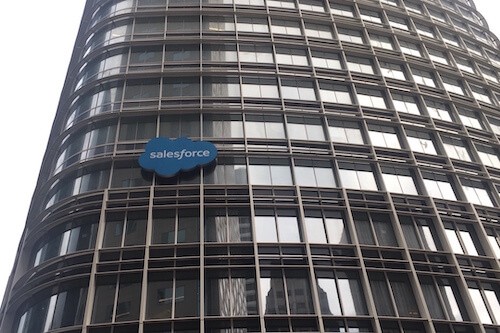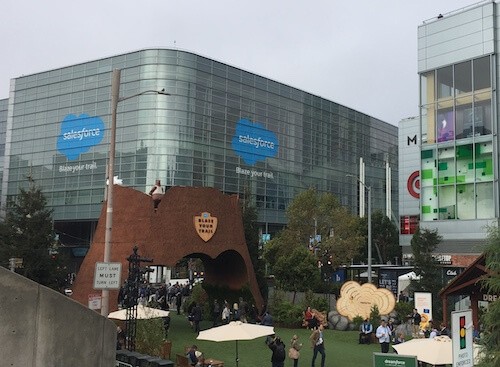Salesforce, Inc. has arguably done more to advance the adoption of what’s now commonly known as “cloud software” than any other company.

When Salesforce (the product) was first launched, a majority of businesspeople were distrustful of any third party holding their valuable contact data.
Because of this uneasiness, Salesforce not only needed to sell the idea of using a browser as a CRM (Customer Relationship Management) user interface — the company also had to convince buyers that customer and other data was secure from loss and intrusion.
Keep in mind that Salesforce existed years before Gmail, Facebook, Twitter, iTunes, and many other now-popular cloud brands came along. The company propelled the SaaS (Software as a Service) model.
1999: The Humble Beginnings

Salesforce began in a small apartment in Telegraph Hill in San Francisco.
Marc Benioff decided to leave a lucrative sales career at Oracle in order to pursue a vision.
While Marc Benioff had the idea for Salesforce, there were three other company founders: Parker Harris, Dave Moellenhoff, and Frank Dominguez. The latter two were co-founders at Parker Harris’s previous company.
Funding was initially raised from Oracle’s Larry Ellison (Benioff’s former boss), Dropbox’s early investor Bobby Yazdani, and CNET founder Halsey Minor.
The Salesforce Foundation was founded in December of the year the company was formed. The 1-1-1 model of integrated philanthropy (1% of product, 1% of time, and 1% of resources) continues today under Salesforce.org.
The same year, Jeff Bezos was named Person of the Year by Time Magazine.
2003: The First Dreamforce

The first Dreamforce, Salesforce’s annual convention, was attended by just over 1,000 people and was held at the Westin Hotel in San Francisco.
That number would turn out to be less than 1% of the eventual attendance.
Dreamforce has now become a major San Francisco event, necessitating a multi-day closure of Howard Street, between Moscone Centers North and South. Partners have even published Dreamforce survival guides.
2004: The Initial Public Offering
After five years of steady growth that led to the 8,700 customer mark, Salesforce launched its IPO and raised $110 Million.
The chosen ticker symbol was CRM.
2005: The AppExchange
The Salesforce AppExchange, a third-party marketplace, was launched in 2005. This eCommerce site is for third-party applications that either connect to Salesforce or run natively on the Salesforce platform.
Entire companies have formed around the AppExchange. A prime example is Conga, founded in 2006. There are also industry-focused apps, such as for healthcare.
Today, AppExchange is its own revenue source, as Salesforce currently receives a margin on partner subscription revenue.
2009: A Billion Dollars In Annual Revenue
2009 was the year that Salesforce reached the $1 billion revenue mark. The company ended its fiscal year with over 55,000 customers.
At Dreamforce ’09, Salesforce announced Chatter, which functionality continues to be iterated with each seasonal release.
2011: 100,000 Customers
In July of 2011, Salesforce reached 100,000 customers. Forbes named Salesforce “the world’s most innovative company.”
2013: Acquisition of ‘The Marketing Cloud’
In the company’s second-largest acquisition ever, Salesforce acquired the popular email service provider ExactTarget for $2.5 billion.
The incidental acquisition was Pardot, which ExactTarget had previously acquired.
ExactTarget later became The Marketing Cloud, one of Salesforce’s current core offerings. The Marketing Cloud remains one of Salesforce’s key pillars.
Pardot, now Salesforce Pardot, became Salesforce’s own version of a HubSpot or a Marketo B2B marketing automation system.
The same year, Salesforce1 was launched. The Salesforce1 UX later became the basis for the Salesforce Lightning Experience, which was released in 2016.
2014: The New Industries Business Unit
In April of 2014, Salesforce announced its New Industries Strategy. This was the company’s first large-scale push into vertical markets. Six global industries, including healthcare & life sciences, were a part of this.
The press release stated, “Salesforce.com enables payers, providers, and life science companies to connect with patients and providers wherever they are to improve the patient experience, outcomes, and cost.”
2015: Lightning & Trailhead Announced
At Dreamforce ’15, the Salesforce Lightning Experience was formally announced.
Trailhead was announced in 2015 as “a new way to learn Salesforce.”
2016: Thirteen Acquisitions; Health Cloud
2016 was the most acquisitive year in the history of Salesforce. Acquisitions included the native CPQ tool SteelBrick. It also included the largest purchase price up until that point—$2.86 billion for Demandware.
2016 was also the year that Salesforce announced Health Cloud. The press release stated, “Salesforce is leveraging a comprehensive ecosystem of partners, systems integrators (SIs), and independent software vendors (ISVs) to extend and implement Health Cloud.” J2 Interactive is a solution partner in that ecosystem.
2017: Rapid Growth Continues
By the end of 2017, Salesforce was an $8.3 billion company.
Forbes once again named Salesforce the world’s #1 most innovative company.
2018: New Digs
In early 2018, Salesforce employees began the move from multiple locations into the Salesforce Tower.
The top space that can be occupied is the 61st floor. Salesforce began offering this space to community nonprofits in the fall of 2018.
Partners in the Salesforce ecosystem also occupy space in the new tower.
In March of 2018, Salesforce announced its biggest acquisition ever—a $6.5 billion purchase of integration vendor MuleSoft.
Also in 2018, Marc Benioff declared that the goal of Salesforce is to be a $60 billion company by 2034.
2019: .Com and .Org Become One
In April 2019, Salesforce paid $300 million to merge with Salesforce.org. Salesforce.org now functions as an industry vertical within Salesforce.
2020: The COVID-19 Response & A Major Acquisition
In March 2020, Marc Benioff announced donations of $1 million to UC San Francisco’s COVID-19 Response Fund and $500K to the CDC Foundation’s Emergency Response Fund. Updates about Salesforce’s safety and well-being actions can be found here.
Marc offered free access to Salesforce Health Cloud for emergency response teams, call centers, and care management teams for health systems affected by SARS-CoV-2. J2 supported this offering with a free Quick Start program.
In May 2020, Salesforce announced Work.com, a bundle of technologies & services designed to help businesses reopen quickly and safely.
On December 1, 2020, Salesforce announced that the company would acquire Slack for $27.7 billion. According to Salesforce, Slack will become the new interface for Customer 360.
2021: Expansion of “360”
In April 2021, expanding on the theme of “Customer 360”, Salesforce introduced Digital 360 for Industries. This is a series of pre-built apps or templates for consumer goods, financial services, healthcare, communications & media, the public sector, emergency response management, and nonprofits.
2022: Sustainability as a Core Company Value
In February 2022, Salesforce announced its sustainability vision, which includes protecting oceans and conserving, restoring, and growing 1 trillion trees.
Salesforce also announced the global availability of Net Zero Cloud 2.0 — a solution that tracks greenhouse gas emissions. Sustainability insights are provided through Tableau CRM dashboards.
2023: Layoffs, Riding the GPT Wave
Among broader tech layoffs, it was a tough start to the year at Salesforce with a 10% reduction in the workforce announced in early January.
In a year that OpenAI’s Generative Pre-trained Transformer (GPT) took the world by storm, Marc Benioff tweeted about the coming EinsteinGPT. Stay tuned for more.
J2 Interactive is an award-winning software development and IT consulting firm that specializes in customized solutions for healthcare and life sciences.



